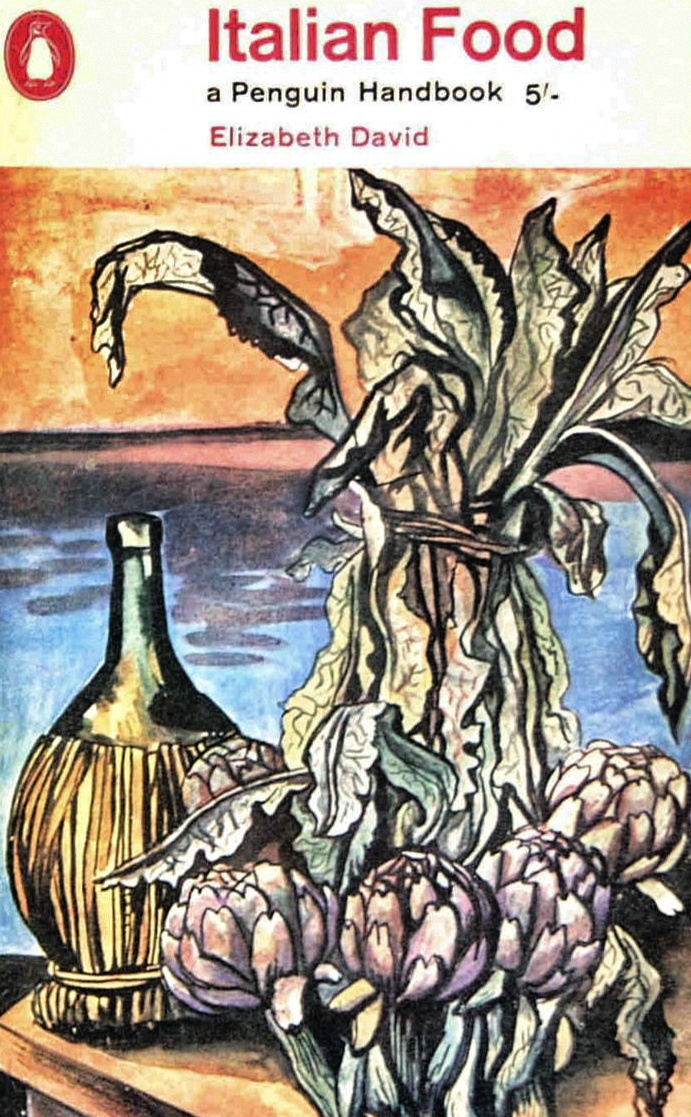I was first introduced to Italian cooking by Elizabeth David. I found her book ‘Italian Food’ in a secondhand shop when I was a student. Spiked thistles, and a straw wrapped bottle of wine drew me to the shelf and the book I bought for pennies revealed itself to be a food-writing first. The illustration ‘Artichokes and Red Wine’ was by one of the most influential artists in Italy during the 1950s and David wrote the first Italian cookbook in English.
The book was published in the same year that ration books eventually disappeared from British households so it was quite a bold move on all fronts. Most of the ingredients were unheard of, and those that were, including olive oil were only available in chemists for treating stubborn earwax. It’s a tour that takes you beyond spaghetti in tomato sauce and looks at the traditions of Tuscany, Umbria, Lombardy and in particular Sicily. For someone whose diet consisted of beans on toast, this was a real eye-opener. Her ragu recipe with chicken livers is a go-to stunner and she lists tomato concentrate as one of the ingredients.
I visited Sicily two decades later and loved the simplicity of life there. Visiting in the summer meant that the weather was incredible and food and drink bountiful and there were hundreds of different varietals of the humble tomato. In fact, more than three hundred types of tomato are grown in Italy. But this wasn’t always the case. Brought to Italy in the sixteenth century by the Spanish, the plants grew exceptionally well in the volcanic soil and with the help of the sun. Whilst the plant was named ‘golden apple’ or pomo d’oro, the fruits weren’t used in Italian cooking until the eighteenth century. The plant looked suspiciously like something related to the nightshade family and was used for ornamental purposes only.
It’s usually in July that the housewives of this beautiful island make their store cupboard staple estratto. Depending on the harvest and the weather, tomatoes in their thousands are preserved, and a thick paste is made for use in the winter. As you wander through the back streets of any Sicilian town, the sweet smell hits you as kilos of fat, juicy spheres are boiled, pressed and their juice extracted. The pulp is spread like red velvet into shallow trays or ladled into terracotta dishes and set out on trestle tables on pavements to dry. When they’re ready the paste is scraped off and put into jars. This concentrated paste adds a dollop of sunshine to any recipe and is no doubt the tasty tomato paste Elizabeth David suggests in her ragu recipe.
As a lover of tomatoes, I’ve also had some degree of success growing small plum tomatoes back home in London and there’s nothing quite like picking your own straight from the vine. The distinctive scent is not only in the air, heightened by the sunshine, but lingers on your hands when a red fruit is picked and there’s nothing quite like it, fresh, green and earthy. Inevitably they’ll be a bowl of sweet tomato salad, drizzled with treacle-thick balsamic vinegar or a heart-warming soup, if the harvest has been particularly kind.
Glorious!’ Sicilian Tomato Balsamic Soup uses just what any Nonna would if she were making her own tomato soup. Sicilian staples from the cucina povera, making the best of what the land has to offer. Nothing fancy, just the freshest ingredients available, treated with respect and made with love.
This blog post is an entry into the Foodies100/GLORIOUS! soup #GloriousAdventures blogger challenge

